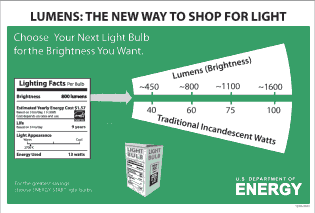New federal lighting regs to help consumers make ‘green’ lighting choices
Starting Jan. 1, 2012, new federal regulations will require the most common light bulbs to be more energy efficient. Specifically, bulbs must produce the same amount of lumens (light output) for less wattage (energy consumption).
All packages of light bulbs sold in stores after the New Year will carry a new Lighting Facts label – modeled after the “Nutrition Facts” labels on food packages – to help consumers compare the brightness and estimated energy costs of various types of light bulbs.
The new label will give consumers information about brightness, known as lumens, energy cost, lifetime, light appearance (“warm” or “cool” light), wattage, and whether the bulb contains mercury.
Traditional, incandescent light bulbs will not meet the new efficiency standards and will no longer be available at most stores.
Traditional 75 watt incandescent light bulbs will no longer be available as of Jan. 1, 2013, and traditional 40 and 60 watt incandescent light bulbs will no longer be available as of Jan.1, 2014.
To measure the brightness, or lumen levels, of lighting types use this rule of thumb:
- Replace a 100-watt incandescent bulb with an energy-saving bulb that gives you about 1600 lumens
- Replace a 75W bulb with an energy-saving bulb that gives you about 1100 lumens
- Replace a 60W bulb with an energy-saving bulb that gives you about 800 lumens
- Replace a 40W bulb with an energy-saving bulb that gives you about 450 lumens.
